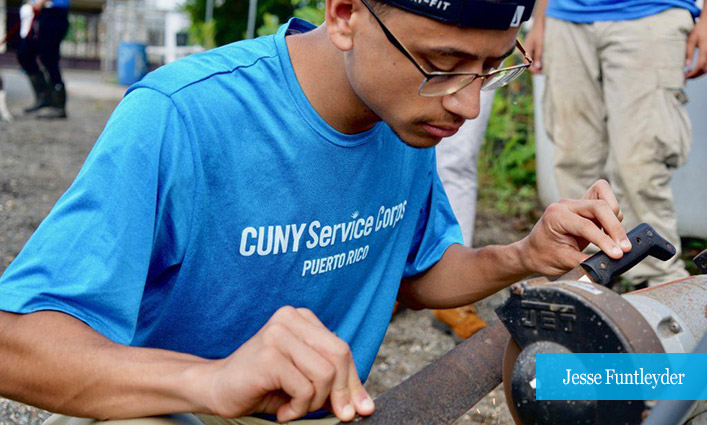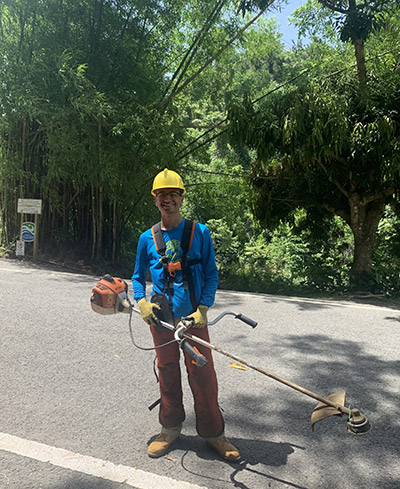
Nearly two years after Hurricane Maria devastated Puerto Rico, CUNY Service Corps volunteers continue to do their part to help rebuild “La Isla del Encanto” (The Island of Enchantment). In June, John Jay’s own Jesse Funtleyder ’21 joined the efforts, traveling to Puerto Rico to assist in the cleanup of homes, agricultural restoration across the island, and the beautification of the island’s national forest. “Despite the help Puerto Rico has received, the island is still in a detrimental situation. They haven’t recovered, tourism is still down, and that is their main source of income,” said Funtleyder, adding that because of the damages he experienced to his home during Hurricane Sandy, this volunteer experience was personal to him. “Many families are still displaced from their homes, and many have become sick after the hurricane. I understand what that’s like because Hurricane Sandy affected my home and we were displaced for eight months and had to do a lot repairs. My hope is that the John Jay community can step up and help out in any way possible.” Wanting to know more about his volunteer experience with CUNY Service Corps and his personal connection to the island, we spoke to Funtleyder about his time in Puerto Rico.
What drew you to volunteer in Puerto Rico?
I wanted to volunteer in Puerto Rico for two reasons. The first one is because my family and I suffered through Hurricane Sandy. Our home is in Rockaway, Queens, New York, so when the hurricane hit, my house was covered by six feet of water. My basement was completely flooded and the first floor of the house was filled with about two feet of water. The damages caused us to be displaced from our home for eight months because of how expensive and challenging the repairs were. My dad, my uncle, and I spent those months cleaning, gutting, and rebuilding the house on our own. Experiencing Hurricane Sandy taught me firsthand what it meant to live through the damages of a natural disaster and come out stronger. I know what it’s like to look at your home and feel hopeless. And, I wanted to give the people of Puerto Rico hope, that everything will be okay.
“Experiencing Hurricane Sandy taught me firsthand what it meant to live through the damages of a natural disaster and come out stronger.”—Jesse Funtleyder
Volunteering in Puerto Rico was also important to me because I am Puerto Rican myself, and I have family who live on the island. Puerto Rico is my favorite place in the world. Seeing the devastation after both Hurricanes Irma and Maria was sad. Many people were left without anything and I knew that I wanted to do whatever I could to help. This trip was an opportunity to turn that devastation into passion, and to give back to the island and people that had given me so much in my life.
What was the focus of this CUNY Service Corps trip to Puerto Rico?
The focus of the trip was to help as many people as we could in Puerto Rico and try to get the island back to how it was before the hurricane, maybe even stronger. I was there for two weeks, and during that time we worked on four different projects. For the first five days of the trip, I helped rebuild the roof of a home that was ravaged by the storm. Generally, this is a project that takes months, so we started with cleaning up everything left over by the storm. Then we reinforced the foundation of the homes by sealing all the cracks with new concrete. And, because of the damage that the storm brought to the roof of these homes, every time it rains it starts to leak inside which causes a lot of them to get mold and mildew inside. While we were fixing the homes, we also tried to get rid of the mold and mildew.
I also had the opportunity to work at this organic farm called Siembra Tres Vida-Trama, for two days. The goal of this project is to help make Puerto Rico self-sustainable again and is part of an island-wide effort to promote a cleaner and environmentally conscious agricultural environment in Puerto Rico. The hope is that this project will inspire others to continue farming and live off of their resources, lowering the cost of living and potentially bringing in more income to the island. After this project, I spent two days at El Yunque National Rainforest, where I helped clear debris off the trails. Even after all the efforts that have been made, there are only a few trails opened. And, La Mina Trail, one of the most popular trails there because of the beautiful waterfall, is still closed. But, we were able to clear up parts of La Mina by using machetes to cut down the overgrown grass, and by moving large rocks and trees. For a day, I also worked on a wetland farm that is growing Mangrove trees for protection from future natural disasters.
What was it like volunteering with CUNY Service Corps?
It was a great experience. We actually partnered with NECHAMA – Jewish Response to Disaster, an amazing nonprofit organization that provided housing for us. CUNY Service Corps did a great job at putting the team of volunteers together. We were a group of people from all over the CUNY system. We came from different backgrounds and experiences but we all had the same intention to help Puerto Rico. At first, I wondered how we would all get along, since we were so different and had just met. We were expected to work as a team within 24 hours of knowing each other, so I was a little skeptical. However, within a day of working alongside the CUNY Service Corps team, I no longer felt like we were volunteers who just met each other. It felt like we were a family.
“Within a day of working alongside the CUNY Service Corps team, I no longer felt like we were volunteers who just met each other. It felt like we were a family.”—Jesse Funtleyder
Every single one of us changed our routines by going to Puerto Rico. We would wake up at 6:00 a.m. every day, eat whatever we were served, and work from 7:00 a.m.– 4:00 p.m. in grueling heat. Everyone worked hard and would come back to base with cuts and bruises that were symbolic of our hard work. We bonded over the same goal and even when we weren’t working, we were connecting over the food and the chance to explore the island. I admire and am very proud of the people I was able to work with for those two weeks.

What did you learn while you were there?
I learned so many practical skills that I have been able to implement here at home. Before going to Puerto Rico, I had some knowledge about construction, so I knew a lot of what we were working on; however, this experience taught me how to properly use power tools, how to seal cracks on walls and ceilings, how to apply concrete, and how to grow mangroves. I learned how to create organic fertilizer, and how to recycle more efficiently. But something that I loved learning about was the history of my Puerto Rican people and how resilient we can be.
What was the interaction like with the people you were helping?
I remember that the people we helped kept saying, “I don’t know how to thank you.” But knowing that they appreciated the work we were doing, and that they recognized our desire to want to help them, was more than enough for me. Everyone we helped was so kind and loving, and would often feed us, share stories, and were genuinely interested in learning more about us. Most of their stories were about the hardships after the hurricane. They would tell us about the possessions they lost, the damages to their homes, and the families members they lost because of the hurricane. Despite all this, they saw the bright side. A lot of the people we met would tell us that the hurricane gave them an opportunity to live better and happier lives. It gave them a chance to rebuild their homes and create a stronger Puerto Rico.
“Everyone we helped was so kind and loving, and would often feed us, share stories, and were genuinely interested in learning more about us.”—Jesse Funtleyder
How do you think your trip falls in line with your justice-focused education that you’re receiving at John Jay?
I am studying to be a forensic mental health counselor. My education at John Jay is centered on the idea of using knowledge—whether from hands-on experience or from the classroom—to help others get better. This entire trip was about helping the people of Puerto Rico. I was surprised at how much work we were able to do and how many people we were able to help. For the duration of the two weeks that we were there, NECHAMA had an itinerary planned out for us that encompassed so many goals and tasks. I enjoyed volunteering in Puerto Rico as it helped me gain hands-on experience that I can use in my future career.
What was your best memory of the trip?
My favorite memory comes from La Mina Trail. I was walking with the director of the park rangers and my NECHAMA team leader. We were cleaning the heavy debris off the trail and talking about the island, traveling, and about our lives. I was in my favorite place of the island, talking with two great people, and doing meaningful work, it was a very fulfilling moment. I remember that while we were walking, the director of the park rangers turned to me and said that if I ever go back, that I will always have a friend. It’s nice to know that during the short time we were there, we had such an impact not only on the director of the park rangers, but on the people too.
If you could give advice to another John Jay student who may want to participate in a volunteer experience like this one, what would you tell them?
I would tell them that it’s a priceless experience and that this has been the most fulfilling thing I’ve done in my life. I was able to give back to an island that has given so much to me, while becoming closer to the people that I call my own. It was such an amazing experience that I am grateful for. I met so many wonderful people, and made a second family for life. People sometimes consider volunteering experiences like this one work, but every second that I was there felt more like a gift. I was able to learn, get stronger, laugh, make lifetime friendships, and bring people joy. But most of all, I was able to help people who probably thought they would never get back to their normal life.



